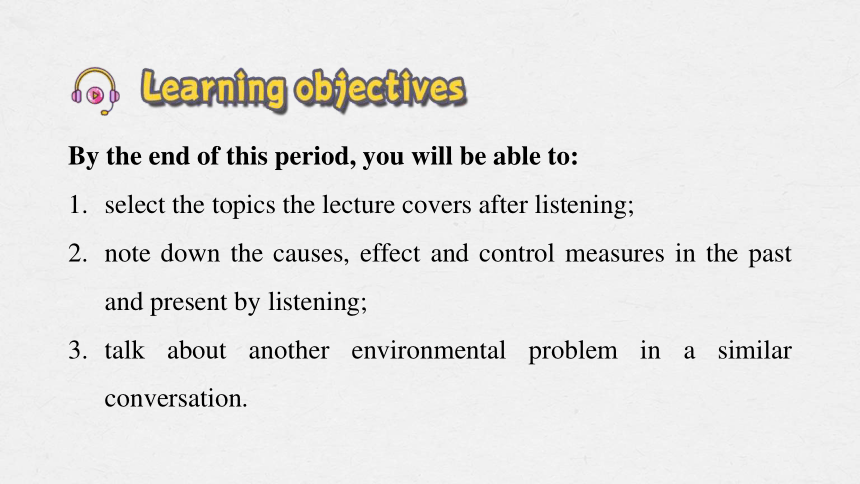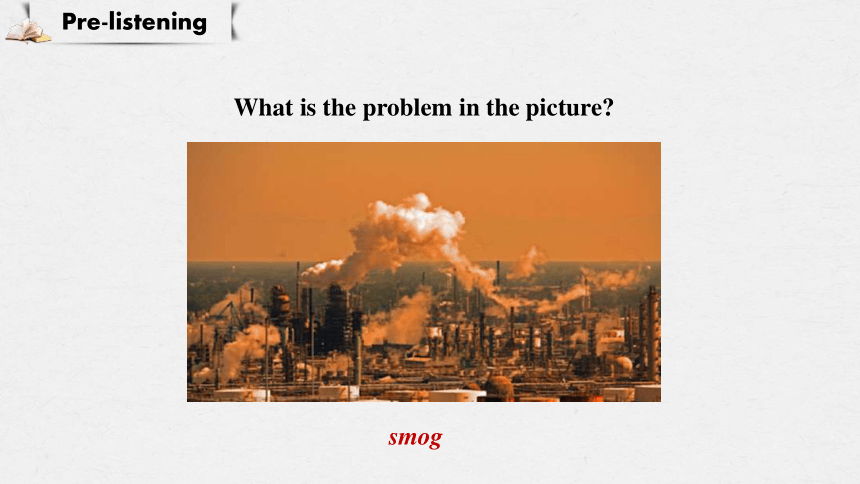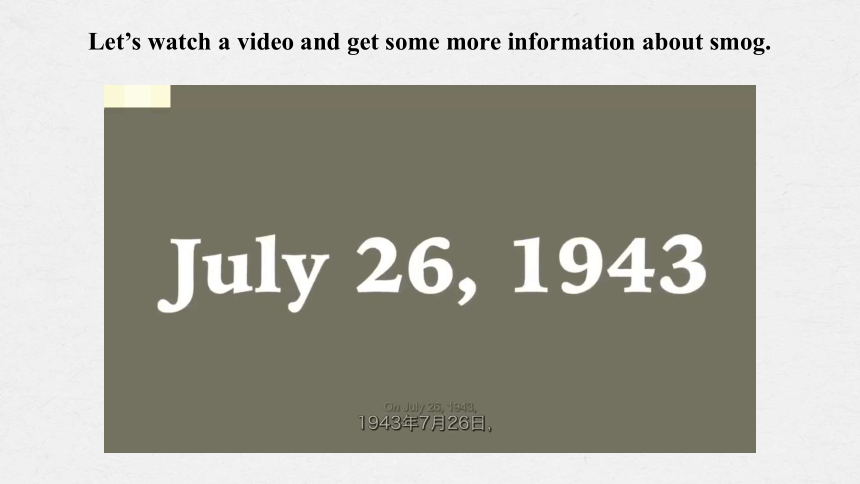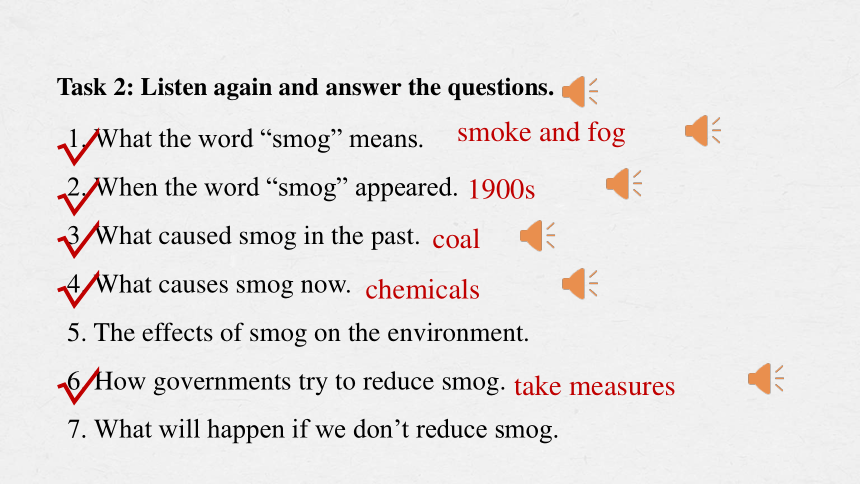外研版(2019)必修 第二册Unit 6 Earth first Usinglanguage(2):Listening 课件 (共17张PPT,内镶嵌音频)
文档属性
| 名称 | 外研版(2019)必修 第二册Unit 6 Earth first Usinglanguage(2):Listening 课件 (共17张PPT,内镶嵌音频) |  | |
| 格式 | pptx | ||
| 文件大小 | 59.7MB | ||
| 资源类型 | 教案 | ||
| 版本资源 | 外研版(2019) | ||
| 科目 | 英语 | ||
| 更新时间 | 2024-04-30 22:27:43 | ||
图片预览







文档简介
(共17张PPT)
Using language(2):Listening
Unit 6 Earth first
By the end of this period, you will be able to:
select the topics the lecture covers after listening;
note down the causes, effect and control measures in the past and present by listening;
talk about another environmental problem in a similar conversation.
What is the problem in the picture
smog
Pre-listening
n.雾
Smog comes from the words “smoke” and “fog”, and it is used to describe the air pollution in cities caused mainly by traffic and factories. Smog can be dangerous because it causes severe breathing problems and infections.
n.烟雾,雾霾
adj.(问题、伤势、传染病)很严重的
n.感染,传染病
Did you know
Let’s watch a video and get some more information about smog.
1. What the word “smog” means.
2. When the word “smog” appeared.
3. What caused smog in the past.
4. What causes smog now.
5. The effects of smog on the environment.
6. How governments try to reduce smog.
7. What will happen if we don’t reduce smog.
Task 1: Listen and choose the topics that are covered.
√
√
√
√
√
While-listening
1. What the word “smog” means.
2. When the word “smog” appeared.
3. What caused smog in the past.
4. What causes smog now.
5. The effects of smog on the environment.
6. How governments try to reduce smog.
7. What will happen if we don’t reduce smog.
smoke and fog
1900s
coal
chemicals
take measures
Task 2: Listen again and answer the questions.
√
√
√
√
√
Task 3: Listen again and complete the slides.
Smog in the past
Term created in: 1._______
Big problem in London:
2.________________ in December 1952
Causes of the problem: burning too much coal
and 3.___________
1900s
The Great Smog
no wind
Check your answers.
Smog in the present
Causes of the problem: 4.___________________________
and factories
Measures: rules about using 5.__________ in factories and 6.____________________________ in the city centre.
chemicals coming from traffic
chemicals
requirements of paying to drive
Check your answers.
Lecturer: Good evening, everyone, and thank you for coming to today’s talk. I’m Dr
Brown and I’m going to talk about air pollution in cities—what we all
know as “smog”. Please______________________ if you have any questions. So, first
of all, a bit of history. The term “smog” was first used in the 1800s in
cities that had problems with smoke and fog.
Student A: ______________________, but I believe it was in the 1900s.
Lecturer: Sorry, I made a mistake…The problem was that there was no wind, so thick
smog covered the city. Nowadays...
Student B: ________________________—did the smog cause any deaths
Lecturer: I’m afraid so. According to research, about 4,000 people are known…
Sorry, for interrupting
feel free to stop me
Task 4: Listen again and complete the dialogue.
Excuse me, but can I just ask
…
Now, let’s look at what smog does to our health...
Student A: _________________________...Can you give us examples of these measures
Lecturer: Well, for example, factories must follow rules about what chemicals
they use. In some cities, when there’s smog, people have to pay to drive in the
centre. Now, let’s move on to the impact of smog on our health...
If I could just stop you again
Learning to learn:
A polite interruption is usually framed as a request for permission to interrupt someone, often starting with If..., May I... or Can I... This may be preceded with an apology such as Sorry, ... or Excuse me, ... Usually we interrupt someone when they pause for breath, or during the slight pause between spoken clauses.
Lecturer: Good evening, everyone, and thank you for coming to today’s talk. I’m Dr
Brown and I’m going to talk about air pollution in cities—what we all know as “smog”. Please feel free to stop me if you have any questions. So, first of all, a bit of history. The
term “smog” was first used in the 1800s in cities that had problems with smoke and fog.
Student A: Sorry, for interrupting, but I believe it was in the 1900s.
Lecturer: Sorry, I made a mistake.You are right. It was in the 1900s. Thank you. London
was one of the cities where smog caused big problems. In December 1952, it suffered
from “The Great Smog”. It was a very cold winter, so a lot of coal was burned at home
and in the factories. The problem was that there was no wind, so thick smog covered the
city. Nowadays...
Listening text
打扰,打断
Student B: Excuse me, but can I just ask—did the smog cause any deaths
Lecturer: I’m afraid so. According to research, about 4,000 people are known to
have died as a result of the smog, but that number could be much higher. It was
terrible! Nowadays, smog still exists, but is produced by chemicals coming from
traffic and factories. However, governments are taking measures to reduce smog as much as possible.Now, let’s look at what smog does to our health...
Student A: If I could just stop you again...Can you give us examples of these measures
Lecturer: Well, for example, factories must follow rules about what chemicals
they use. In some cities, when there’s smog, people have to pay to drive in the
centre. Now, let’s move on to the impact of smog on our health...
采取措施
Work in pairs. Talk about another environmental problem and have a similar conversation.
Student A: Turn to Page 108.
Student B: Turn to Page 111.
Post-listening
Now work with your deskmate to act out the conversation.
Show Time
Using language(2):Listening
Unit 6 Earth first
By the end of this period, you will be able to:
select the topics the lecture covers after listening;
note down the causes, effect and control measures in the past and present by listening;
talk about another environmental problem in a similar conversation.
What is the problem in the picture
smog
Pre-listening
n.雾
Smog comes from the words “smoke” and “fog”, and it is used to describe the air pollution in cities caused mainly by traffic and factories. Smog can be dangerous because it causes severe breathing problems and infections.
n.烟雾,雾霾
adj.(问题、伤势、传染病)很严重的
n.感染,传染病
Did you know
Let’s watch a video and get some more information about smog.
1. What the word “smog” means.
2. When the word “smog” appeared.
3. What caused smog in the past.
4. What causes smog now.
5. The effects of smog on the environment.
6. How governments try to reduce smog.
7. What will happen if we don’t reduce smog.
Task 1: Listen and choose the topics that are covered.
√
√
√
√
√
While-listening
1. What the word “smog” means.
2. When the word “smog” appeared.
3. What caused smog in the past.
4. What causes smog now.
5. The effects of smog on the environment.
6. How governments try to reduce smog.
7. What will happen if we don’t reduce smog.
smoke and fog
1900s
coal
chemicals
take measures
Task 2: Listen again and answer the questions.
√
√
√
√
√
Task 3: Listen again and complete the slides.
Smog in the past
Term created in: 1._______
Big problem in London:
2.________________ in December 1952
Causes of the problem: burning too much coal
and 3.___________
1900s
The Great Smog
no wind
Check your answers.
Smog in the present
Causes of the problem: 4.___________________________
and factories
Measures: rules about using 5.__________ in factories and 6.____________________________ in the city centre.
chemicals coming from traffic
chemicals
requirements of paying to drive
Check your answers.
Lecturer: Good evening, everyone, and thank you for coming to today’s talk. I’m Dr
Brown and I’m going to talk about air pollution in cities—what we all
know as “smog”. Please______________________ if you have any questions. So, first
of all, a bit of history. The term “smog” was first used in the 1800s in
cities that had problems with smoke and fog.
Student A: ______________________, but I believe it was in the 1900s.
Lecturer: Sorry, I made a mistake…The problem was that there was no wind, so thick
smog covered the city. Nowadays...
Student B: ________________________—did the smog cause any deaths
Lecturer: I’m afraid so. According to research, about 4,000 people are known…
Sorry, for interrupting
feel free to stop me
Task 4: Listen again and complete the dialogue.
Excuse me, but can I just ask
…
Now, let’s look at what smog does to our health...
Student A: _________________________...Can you give us examples of these measures
Lecturer: Well, for example, factories must follow rules about what chemicals
they use. In some cities, when there’s smog, people have to pay to drive in the
centre. Now, let’s move on to the impact of smog on our health...
If I could just stop you again
Learning to learn:
A polite interruption is usually framed as a request for permission to interrupt someone, often starting with If..., May I... or Can I... This may be preceded with an apology such as Sorry, ... or Excuse me, ... Usually we interrupt someone when they pause for breath, or during the slight pause between spoken clauses.
Lecturer: Good evening, everyone, and thank you for coming to today’s talk. I’m Dr
Brown and I’m going to talk about air pollution in cities—what we all know as “smog”. Please feel free to stop me if you have any questions. So, first of all, a bit of history. The
term “smog” was first used in the 1800s in cities that had problems with smoke and fog.
Student A: Sorry, for interrupting, but I believe it was in the 1900s.
Lecturer: Sorry, I made a mistake.You are right. It was in the 1900s. Thank you. London
was one of the cities where smog caused big problems. In December 1952, it suffered
from “The Great Smog”. It was a very cold winter, so a lot of coal was burned at home
and in the factories. The problem was that there was no wind, so thick smog covered the
city. Nowadays...
Listening text
打扰,打断
Student B: Excuse me, but can I just ask—did the smog cause any deaths
Lecturer: I’m afraid so. According to research, about 4,000 people are known to
have died as a result of the smog, but that number could be much higher. It was
terrible! Nowadays, smog still exists, but is produced by chemicals coming from
traffic and factories. However, governments are taking measures to reduce smog as much as possible.Now, let’s look at what smog does to our health...
Student A: If I could just stop you again...Can you give us examples of these measures
Lecturer: Well, for example, factories must follow rules about what chemicals
they use. In some cities, when there’s smog, people have to pay to drive in the
centre. Now, let’s move on to the impact of smog on our health...
采取措施
Work in pairs. Talk about another environmental problem and have a similar conversation.
Student A: Turn to Page 108.
Student B: Turn to Page 111.
Post-listening
Now work with your deskmate to act out the conversation.
Show Time
